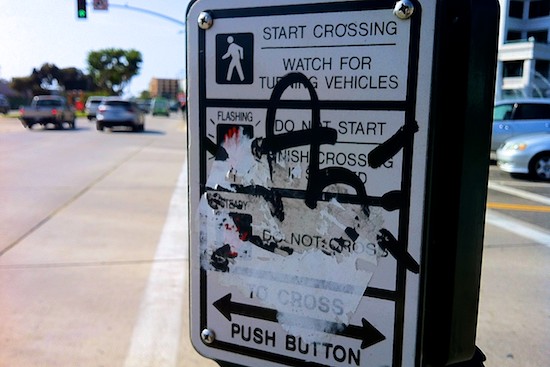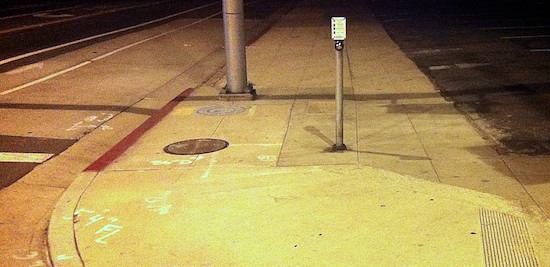(We're inching closer to the launch of Santa Monica Next. Read more about it here and here. Give us a Kick Start to help us get going, here. - DN)
Regulating and designing around the assumption everyone drives leads to highway expansions and parking garage build outs that make it easier and more convenient to drive. Despite temporary traffic relief, we frequently arrived back at the congestion situation that justified expanding before.
The assumptions we make influence the outcomes we get, and induced demand in highway building is frequently railed against by advocates of transportation reform. On the flip side of the driving assumptions that inform our land use and transportation policies, we also have a range of baked in assumptions in our infrastructure about how people won’t be walking or biking. When we do plan for walking, we still assume that the amount of walking isn't very high.
Sometimes these assumptions are subtle and unquestioned, such as the very existence of pedestrian crossing push buttons at signalized intersections.
These devises are sometimes disparagingly referred to as “beg buttons” by many pedestrian activists because you are essentially having to ask for permission to have a crossing signal phase. Beg buttons are one of the more subtle means by which we degrade the urban environment for walking, and Streets.MN has a handy typological guide. The buttons exist for driver convenience, not walking convenience. The absence of an assumed pedestrian phase permits greater optimizations of green times for the prioritized vehicle travel direction. It took me a long while to realize this relationship, but now I take note of everywhere I see them, or don't see them.
Within certain blocks or for portions of some streets in Santa Monica, we do assume an appropriate pedestrian crossing phase every cycle without buttons, mostly notably around the more tourist drawing downtown and promenade. One of the things about Washington D.C. that most impressed me as a city, was the distinct absence of beg buttons everywhere that I went all over the city, and intersection signals that all assumed people on foot would cross. This was consistent throughout my experience for nearly a week wandering around until finally finding a few beg buttons near the D.C. Union Station.
You become a lot more aware of how annoying certain aspects of the status quo are once you experience a place operating under differing paradigms. Sometimes a beg button is in a awkward spot to reach, sometimes you walk up and think the person in front of you hit, but had not, and you don’t want to reach across them to do it or presume they had not and tell them to. Then you end up missing an entire crossing phase.
These kind of little indignities add up, along with far worse offenses pedestrians deal with, to send the message that be a human is secondary to being poorly trained automobile pilots. When I step back from our culture for a second and ponder this, it feels so incredibly backward. Tom Vanderbilt rightfully referred to this state of affairs as a "crisis in American walking" in his series for Slate, a worthwhile long read if you missed it.
There is also a secondary benefit for bike riders as well by assuming that pedestrians exist at intersections, and providing the appropriate crossing phases as such. Intersection signals which continue to not properly detect bicycles, would always cycle through, instead of sometimes holding green to only one direction until triggered otherwise. Super short minimum green times that some intersections have would also no longer be an issue if you start from assuming a pedestrian crossing sufficient phase. There are some residential streets where the green time to cross as a bicyclist is so short, hardly green for a moment, that even as someone who can accelerate quickly I barely get through before yellow is going to red.
Then there is the matter of the pedestrian crossing durations, which are not always adequate, even when you have appropriately begged the infrastructure for a glowing icon of permission. In a few such cases I've observed, it was reported using the GoRequest app, and I was happy to see the signal time was later extended (the city of Santa Monica is pretty good about responding to obvious issues with quick fixes), but I have no doubt many places still exist where the crossing time remains rushed and certainly inadequate for someone slower.
If you see a crossing time that is clearly too short, I urge that you report it, even if it might not be a big deal to you personally. For someone in other circumstances it could become a stressful or potentially dangerous experience if they encounter such a crossing. I have certainly seen sketchy moments with someone crossing and not making it in time despite walking right at the signal change.
I know that for the traffic engineers, they are in a position of trying to meet obligations we've structured around private automobile centric "level of service", but the whole paradigm of level of service needs to be confronted. Level of service for whom, and why? The "level of service" for street users that aren't driving needs to be on a more level playing field. There is always going to be some vocal push back to anything that dares threaten even half a second of green time for a driver, but there are also many potential gains to made for everyone if we encourage more non-automotive trips. We need more vocal pushing and pulling in the other direction.
If any municipality in the Los Angeles region can advance a strong model of truly pedestrian oriented principles, it’s Santa Monica. However seeing beg buttons go up at 14th St. & Broadway not long ago, an intersection I walk frequently and where pedestrian crossing phases were default previously, was at least one small step backward. The street light pole being set back far, because of the location of the drain, resulted in this weird small post placement right in the middle of the sidewalk. I doubt there was any ill will intended to pedestrians in this routine change, but changes that might negatively impact a pedestrian's "level of service" have often become just standard operating procedure in our society.
Pedestrian prioritization and crossings without begging should be becoming the norm in more places, not fewer. Especially in anticipation of a post Expo Line Santa Monica with potentially tens of thousands of more people walking to and from transit connections we want people to utilize over driving. So let's stop assuming pedestrians will not be present until they push to indicate otherwise.









